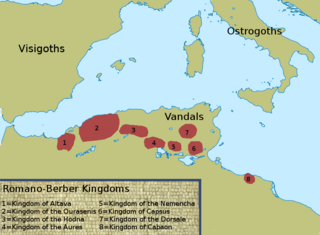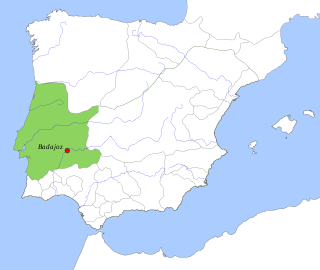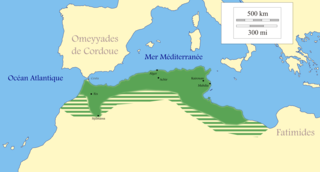 W
WThe Almohad Caliphate was a North African Berber Muslim empire founded in the 12th century. At its height, it controlled much of the Iberian Peninsula and North Africa.
 W
WThe Barghawatas were Berber tribal confederation on the Atlantic coast of Morocco, belonging to the Masmuda confederacy. After allying with the Sufri Kharijite rebellion in Morocco against the Umayyad Caliphate, they established an independent state in the area of Tamesna on the Atlantic coast between Safi and Salé under the leadership of Tarif al-Matghari.
 W
WThe Hammadid dynasty was a Sanhaja Berber dynasty that ruled an area roughly corresponding to north-eastern modern Algeria between 1008 and 1152. Its realm was conquered by the Almohad Empire.
 W
WThe Kingdom of the Ait Abbas or Sultanate of the Beni Abbas, was a Berber state of North Africa, then a fief and a principality, controlling Lesser Kabylie and its surroundings from the sixteenth century to the nineteenth century. It is referred to in the Spanish historiography as "reino de Labes"; sometimes more commonly referred to by its ruling family, the Mokrani, in Berber At Muqran. Its capital was the Kalâa of Ait Abbas, an impregnable citadel in the Biban mountain range.
 W
WThe Kingdom of Altava was an independent Berber kingdom centered on the city of Altava in present-day northern Algeria. The Kingdom of Altava was a successor state of the previous Mauro-Roman Kingdom which had controlled much of the ancient Roman province of Mauretania Caesariensis. This Kingdom collapsed following Eastern Roman military campaigns to decrease its influence and power after Garmul invaded the Exarchate of Africa.
 W
WThe Kingdom of Kuku was a Kabyle Berber kingdom that ruled over much of greater Kabylia. It was established around 1515. The polity's realm stretched from the Atlas Mountains to the southern plains of Algiers. Its capital was located at Kuku, which sat on a promontory with around 15,000 inhabitants. The kingdom had forces consisting of 5,000 musqueteers and 1,500 cavalrymen.
 W
WThe Marinid Sultanate was an empire from the mid-13th to the 15th century which controlled present-day Morocco and, intermittently, other parts of North Africa and of southern Spain around Gibraltar. It was named after the Banu Marin, a Zenata Berber tribe. The sultanate was ruled by the Marinid dynasty, or Banu Abd al-Haqq, a family which led the tribe to power.
 W
WMidrarid dynasty was a Berber dynasty that ruled the Tafilalt region in Morocco. It was established by the Berber Miknasi leader Abul-Qasim Samku. The source for which details of his reign are told by Al-Bakri who lived in the following century; Ibn Idhari also mentions him, but he lived in the thirteenth and fourteenth centuries, and Ibn Khaldun and some other minor historians, including at least two contemporary but partial sources.
 W
WThe Kingdom of Nekor was an emirate centered in the Rif area of present-day Morocco. Its capital was initially located at Temsaman, and then moved to Nekor. The dynasty was founded in 710 CE by Salih I ibn Mansur through a Caliphate grant. Under his guidance, the local Berber tribes adopted Islam, but later deposed him in favor of one az-Zaydi from the Nafza tribe. They subsequently changed their mind and reappointed Ibn Mansur. His dynasty, the Banū Sālih, thereafter ruled the region until 1019.
 W
WNumidia was the ancient kingdom of the Numidians located in what is now Algeria and a smaller part of Tunisia and small part of Libya in the Maghreb. The polity was originally divided between Massylii in the east and Masaesyli in the west. During the Second Punic War, Masinissa, king of the Massylii, defeated Syphax of the Masaesyli to unify Numidia into one kingdom. The kingdom began as a sovereign state and later alternated between being a Roman province and a Roman client state.
 W
WThe Taifa of Albarracín was a medieval Berber taifa kingdom. The polity existed from 1012 to 1104, and was centered at the city of Albarracín. It was led by the Berber dynasty of the Banu Razin of Houara tribe, which arrived in the peninsula after the conquest of Spain by Tariq ibn Ziyad.
 W
WThe Taifa of Alpuente was a medieval Berber taifa kingdom that existed from around 1009 to 1106 created following the end of the Caliphate of Córdoba in the Iberian Peninsula in 1010. It was ruled by the Kutama Berber family of the Banū Qāsim.
 W
WThe Taifa of Arcos was a Berber medieval taifa kingdom that existed in two periods; first from 1011 to 1068. Ruled by the Zanata Berber family of the Banū Jizrūn. From 1068 until 1091 it was under the forcible control of Seville, by Abbad II al-Mu'tadid. It regained its independence from 1143 to 1145 when it was finally conquered by the Almohad Caliphate.
 W
WThe Taifa of Badajoz was a medieval Islamic Moorish kingdom located in what is now parts of Portugal and Spain. It was centred on the city of Badajoz which exists today as the first city of Extremadura, in Spain.
 W
WThe Taifa of Carmona was a medieval Berber taifa kingdom. It existed for two distinct periods: first from 1013 to 1066 when it was conquered by the Taifa of Seville, and secondly from around 1143 to 1150 when it was finally conquered by the Almohad Caliphate. The taifa was established and ruled by the Zenata Berber Birzalid dynasty.
 W
WThe Taifa of Granada was a Berber emirate in Al-Andalus, roughly corresponding to the modern province of Granada, Spain, in southern Spain. The emirate originated in 1013 and lasted until 1091.
 W
WThe Taifa of Morón was a medieval Berber taifa kingdom that existed from around 1010 to 1066. From 1066 until 1091 it was under the forcible control of Seville, by Abbad II al-Mu'tadid.
 W
WThe Taifa of Ronda was a medieval Berber taifa kingdom centered in Moorish al-Andalus in what is now southern Spain. It existed from 1039 to 1065. The taifa was ruled by a family from the Berber Banu Ifran tribe of North Africa. Its capital was the city of Ronda. From 1065 until 1091, the taifa was under the control of the Taifa of Seville, led by Abbad II al-Mu'tadid.
 W
WThe taifa of Toledo was a Berber Muslim taifa located in what is now central Spain. It existed from the fracturing of the long-eminent Muslim Caliphate of Córdoba in 1035 until the Christian conquest in 1085.
 W
WThe Kingdom of Tlemcen or Zayyanid Kingdom of Tlemcen was a Berber kingdom in what is now the northwest of Algeria. Its territory stretched from Tlemcen to the Chelif bend and Algiers, and reached at its zenith the Moulouya River to the west, Sijilmasa to the south and the Soummam to the east.
 W
WThe Wattasid dynasty was a ruling dynasty of Morocco. Like the Marinid dynasty, its rulers were of Zenata Berber descent. The two families were related, and the Marinids recruited many viziers from the Wattasids. These viziers assumed the powers of the Sultans, seizing control of the Marinid dynasty's realm when the last Marinid, Abu Muhammad Abd al-Haqq, who had massacred many of the Wattasids in 1459, was murdered during a popular revolt in Fez in 1465.
 W
WThe Zirid dynasty was a Sanhaja Berber dynasty from modern-day Algeria which ruled the central Maghreb from 972 to 1014 and Ifriqiya from 972 to 1148.